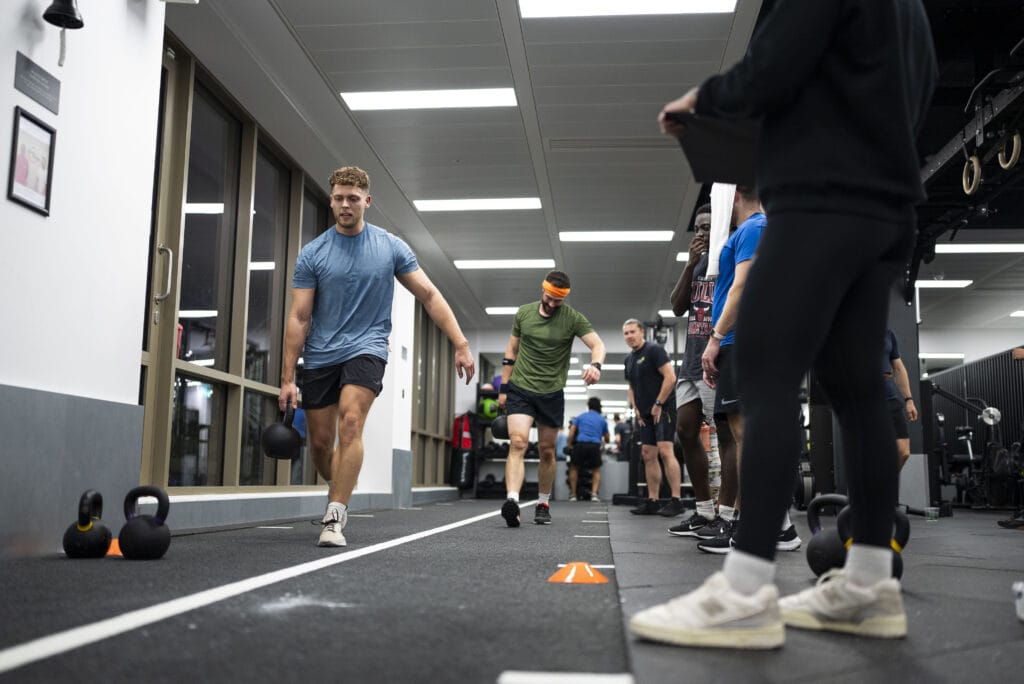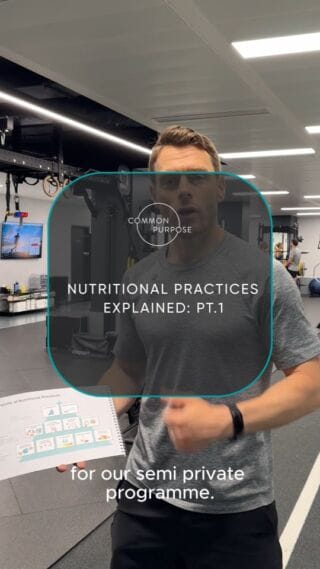Whether you’re striving for a specific athletic goal, like health and longevity, or aiming to become a versatile all-rounder, capable of engaging in a diverse array of physical activities, our mission at Common Purpose is to unlock your full potential and help you achieve your performance goals through our One to One PT and Semi Private PT offerings.
We design our training programmes using evidence-based methods, ensuring they meet our members’ needs and goals. With our experienced and motivating personal trainers, our members benefit from the latest training techniques to become the fittest, strongest, and most athletic version of themselves.
At Common Purpose, we understand that many of our clients come to us to improve their physique. After all, who doesn’t want to feel more confident in their own skin? We’ve had the pleasure of helping many achieve their body composition goals, boosting their confidence, health, and vitality. While everyone’s ideal physique is different, most aim to lose fat and gain muscle to varying degrees.
What is Recomposition?
Recomposition is the process of losing fat while maintaining, or even gaining, muscle. Achieving both of these is the key to a toned, sculpted physique. Recomposition requires certain strategies for training and nutrition along with consistent practice and attention to detail.

Is it Possible to Gain Muscle and Lose Fat at the Same Time?
Yes, it is possible to gain muscle and lose fat simultaneously, even for trained individuals, but it requires a strategic approach to nutrition and training. Some people find it easier to gain muscle and lose fat in separate phases, “bulking” for growth, and “cutting” for fat loss. You can however build muscle and lose fat at the same time, it just takes a balanced approach that promotes both muscle growth and fat reduction – and maybe a bit of patience at times.
What Type of Training is Best for Body Recomposition?
There are typically two types of training that are discussed when it comes to improving body composition:
1) Cardiovascular Training: This type of training improves the efficiency of your heart, lungs, muscular and circulatory system, aiding in overall fitness and endurance. Cardiovascular training can be broken down into aerobic training and anaerobic training. Aerobic training is continuous cyclical exercise (running, swimming, cycling etc) at low-medium intensities sustained over extended periods of time. Anaerobic Training is high-intensity, short-duration exercise intervals dispersed with bouts of recovery.
2) Resistance Training – a style of exercise training that cause muscles to contract against an external resistance, such as weights, resistance bands, or body weight, to increase muscle strength, strength-endurance and size.
Cardiovascular Training for Recomposition
According to research, it seems that cardiovascular training is slightly more effective for fat loss over resistance training. This could be because you expend more energy during this type of training. Cardiovascular training also increases the number and function of cellular mitochondria, which can improve the cell’s ability to convert food into energy, as opposed to storing it as fat. Lower intensity aerobic training may prioritise the use of fat as fuel during exercise. In the context of body recomposition, the modality (jogging, cycling, swimming, elliptical etc) and intensity (steady state or intervals) of this type of training really depends on individual preference and current fitness / conditioning levels.

Resistance Training for Recomposition
Although resistance training isn’t the best training modality for fat loss itself, it plays a significant role in preserving, or even gaining lean muscle mass whilst losing fat. Over time, increasing lean muscle mass may also contribute to higher metabolic rates (muscle is a much more metabolically active tissue compared to fat) and improve the capacity for muscles to utilise carbs as fuel, helping to maintain a lean physique, amongst other benefits such as insulin sensitivity.
General Daily Activity
It’s also worth noting that increasing general daily activity (measured via step count) can also accelerate fat loss by expending more energy throughout the day. Daily movement also improves recovery from training sessions without compromising muscle mass loss.
Training Strategies For Body Recomposition
The frequency, intensity and duration of aerobic, anaerobic and resistance training will vary from person to person, however here’s where we would start for trained and untrained individuals looking to improve their body composition:
Untrained Individuals:
- Beginner-Friendly Resistance Training: Start with a well-structured, balanced resistance training program 1-2 times per week focusing on form and gradually increasing intensity. Basic movements and free weights can help build a strong foundation.
- Build Aerobic Base: Incorporate low-moderate intensity aerobic training 1-2 times per week sessions to build an aerobic base, accelerate fat metabolism and improve recovery from resistance training.
- Moderate step count: 8-10,000 steps/day.

Trained Individuals
- Optimised Resistance Training: Incorporate a progressive strength and hypertrophy program 2-4 times per week.
- Strategic Cardio: Include a blend of aerobic and anaerobic sessions 2-3 times per week.
- Moderate-high step count: 10-15,000 steps/day.
Nutrition for Body Recomposition
Nutrition plays a pivotal role in achieving body recomposition. Here at Common Purpose, we don’t believe that there is one specific diet superior to all others when it comes to body recomposition, but we do believe that there are fundamental evidence-based nutrition principles that must be adhered to in order to be successful at losing fat and gaining muscle.
These principles are as follows:
- Control Calorie balance
- Optimise Macronutrient Distribution
- Focus on Whole food sources
- Ensure Adequate hydration
- Minimise Alcohol Intake
Control Calorie balance
Why?
Calorie balance is integral when it comes to body recomposition. Typically, building muscle means eating more calories than you burn, while losing fat means burning more than you eat. But here’s the twist: you can hit a sweet spot where you’re not overstuffed or starving, and still build muscle. How? By tapping into your body’s stored fat for fuel that helps build muscle (as long as you’re hitting your daily protein and lifting weights along the way).
You’re essentially trying to balance muscle growth without adding extra fat. It’s all about keeping a close eye on what you eat and burn, making sure you’re fuelling muscle protein synthesis and not padding your waistline.
How?
Achieving body recomposition is all about managing your calorie intake to juggle both fat loss and muscle gain.
Here’s the game plan:
First, calculate your estimated total daily energy expenditure (TDEE) using an online calculator. Next, get a grip on your current daily caloric intake by logging everything you eat— there are loads of great tools like Myfitnesspal, MacroFactor etc, to help track calories and macros.
Start by setting your daily caloric intake to 5-10% less than your TDEE. Stick with this for about 4 weeks, and make sure you’re regularly measuring your body composition to keep track of your progress. Consistency is key!
Example:
TDEE = 1950kcal
5% of 1950kcal = 97.5kcal
Average calorie target = 1852.5kcal
Optimise Macronutrient Distribution
Why?
Getting your macronutrients (fats, carbs, and protein) in check is just as crucial as nailing your calorie balance for body recomposition. Protein is your muscle’s best friend, supplying the amino acids needed for muscle repair and growth after those intense workouts. Carbs are your go-to energy source, powering you through your gym sessions and helping to restock your glycogen stores so you’re ready to go again. And fats are key for hormone production and overall health. Just make sure you’re not going overboard, because too much fat can tip the calorie scale in the wrong direction.
How?
Getting your macronutrient balance right can really optimise that recomposition goal. Here’s a guide to kick things off:
- Protein: Aim for 1.6−2.2 grams per kg of your target body weight. Think of it as your muscle-building fuel.
- Fats: Shoot for 0.8−1.0 grams per kg of target body weight. They keep your hormones happy and everything running smoothly.
- Carbs: Use the remaining calories after protein and fats. These are your go-to energy boosters.
Focus on Whole Food Sources
Why?
Ultimately calories and macros are crucial for body composition, but let’s not forget: the source of those calories and macros matters as well. The quality of what you eat influences how well you absorb nutrients and maintain gut health. Nutrient-dense foods packed with fibre, vitamins, and minerals ensure smooth digestion and optimal nutrient uptake, while processed junk can mess with your gut flora and trigger inflammation and cellular dysfunction.

Plus, different foods have different metabolic impacts. Protein-rich foods, for example, burn more calories just through digestion (it has a high “thermic effect”). Whole foods also keep you fuller longer and curb those cravings, making it easier to stick to your calorie goals compared to their processed counterparts.
Overall, prioritising nutrient-dense foods not only supports optimal health and metabolic function but also enhances the long-term success of dietary habits and body composition.
How?
To make the most of your body recomposition efforts, focus on the quality of your food choices. Here’s a simple guide:
- Whole Foods: Load up on fruits, vegetables, lean proteins, whole grains, and healthy fats. These nutrient-packed options keep you healthy and on track.
- Fibre: Aim for 25-30 grams a day. It helps with digestion and keeps you feeling full.
- Micronutrients: Get your vitamins and minerals by eating a colourful variety of fruits and veggies—think of it as eating the rainbow! If you’re not hitting your micronutrient needs through food alone, consider a good supplement.
- Minimise Processed Foods: Cut back on those tempting but unhealthy options like chips, fries, donuts, and pizza. They’re usually packed with added sugars, saturated fats, and refined grains, and don’t do much for satiety.
Stick with these tips, and you’ll be giving your body the best chance to recomposition effectively!
Ensure Adequate Hydration
Why?
Staying hydrated is a game-changer for body composition, supporting a myriad of bodily functions. First off, it provides energy for your workouts, allowing you to crush your exercise routine and stimulate both muscle growth and fat loss.
Drinking enough water helps regulate your appetite and keeps hunger at bay, while also giving your metabolism a boost by aiding in efficient fat metabolism. Since muscles are mostly water, hydration is key to maintaining muscle function and ensuring the smooth transport of nutrients needed for muscle repair and growth.
Ironically, staying well-hydrated can also reduce water retention, helping you achieve that lean, toned look. All these factors combined make proper hydration a critical component for optimising fat loss and muscle gain, leading to a better overall body composition.
How?
Adequate hydration is essential for optimal bodily functions, exercise performance, and nutrient transport.
- General Recommendation: Aim for at least 3 litres of water per day for men and 2.2 litres for women. Adjust based on activity level, climate, and individual needs.
- Monitor Hydration: Check urine colour as a quick gauge; light yellow typically indicates proper hydration.
Minimise Alcohol Intake
As fun as it is, alcohol can mess with your body composition goals. To start, it’s pretty calorie-dense (7 calories per ml), which means you will have to take this into the calorie balance equation. Plus, your body prioritises burning off alcohol over fat, slowing down your fat metabolism. It can also interfere with nutrient absorption, potentially causing nutrient deficiencies.
Alcohol also throws your hormones out of whack, particularly testosterone and oestrogen, which are crucial for muscle growth and fat control. It messes with your sleep, which isn’t great for recovery and muscle maintenance, and it dehydrates you, impacting muscle function and exercise performance.
As well as all of that, alcohol often leads to poor dietary choices and overeating. To keep your body composition in check, moderation and drink mindfully.
How?
- Set Clear Limits: Aim for moderate alcohol consumption. For men, this means up to two drinks per day, and for women, up to one drink per day. Consider setting a weekly limit to keep your intake in check, such as no more than 4-5 drinks per week.
- Choose Wisely: Opt for lower-calorie alcoholic beverages such as light beer, wine, or spirits mixed with soda water or diet mixers. Skip the sugary mixers and cocktails that add unnecessary calories and sugar to your drinks.
- Plan Ahead: Incorporate alcohol-free days into your week to give your body time to recover and focus on your fitness goals. Save alcohol for special occasions rather than making it a regular habit.
- Timing: Alcohol can disrupt sleep patterns, so limit consumption close to bedtime to ensure quality rest and recovery.
- Track Your Intake: Food Diary: Use a food and drink diary or an app like MyFitnessPal to track your alcohol intake along with your calories and macros. Regularly review your consumption habits and their impact on your progress towards body recomposition goals.
- Support: Share your goals with friends, family, or a coach who can help keep you accountable.
- Find alternatives: Engage in social activities that don’t revolve around alcohol, such as sports, fitness classes, or creative hobbies.
Want to start your muscle building journey with one of our expert trainers today? Get in touch.
 Tiago
Tiago



